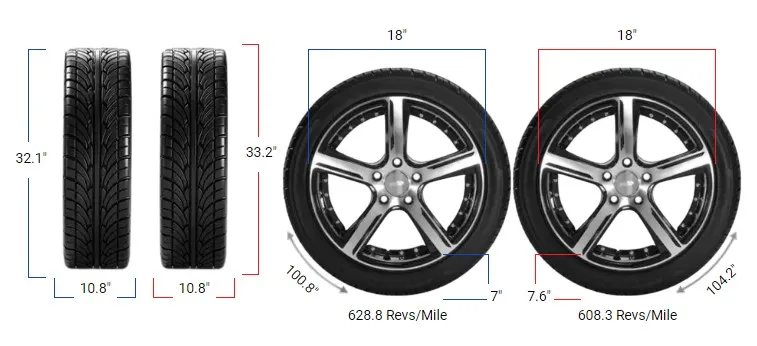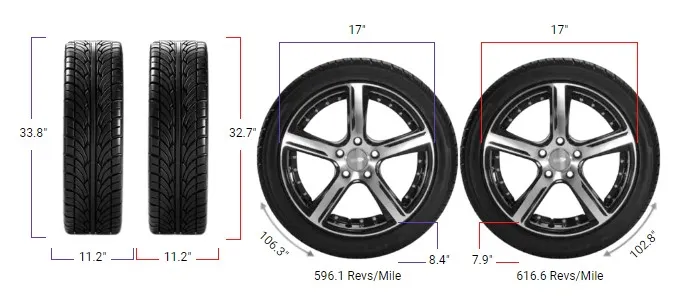195 vs 225 Tires

The most apparent difference between 195 and 225 tires is their width. The 235 tires is about 30 mm wider than the 195 tires. The 195 tire has a width of 195 millimeters, while the 225 tire measures 225 millimeters across the tread.
This extra 30 millimeters may seem modest, but it significantly affects various performance characteristics, such as traction, fuel efficiency, and handling.
A wider tire like the 225 has a larger contact patch with the road, which generally improves traction and stability, particularly in cornering and wet conditions.
On the other hand, a 195 tire provides a narrower contact area, which can lead to less rolling resistance, making it a more fuel-efficient choice. The narrower profile also typically results in lighter steering, which can enhance maneuverability in urban environments.
On-Road Impact
The difference in width between 195 and 225 tires has a significant effect on on-road performance:

- Handling and Stability: The 225 tire offers improved lateral grip due to its larger contact area, which makes it more stable during high-speed cornering and aggressive driving. This additional stability can be beneficial for those who drive on winding roads or enjoy spirited driving.
- Fuel Efficiency: The narrower 195 tire generally offers better fuel economy because of its reduced rolling resistance. The smaller contact area means there’s less friction between the tire and the road, allowing the vehicle to move more efficiently, which can be especially advantageous for long commutes or highway driving.
- Ride Comfort: 225 tires tend to absorb road imperfections better, offering a smoother ride due to the increased contact patch. However, this can also result in increased road noise, particularly on rough surfaces. 195 tires, while not as cushioned, often provide a quieter ride, making them ideal for city driving and smoother highways.
Off-Road Impact
For those who occasionally drive off-road, the choice between 195 and 225 tires can also impact traction and control:

- Traction on Loose Surfaces: The 225 tire offers a wider footprint, which is beneficial for traction on loose surfaces like gravel, sand, or mud. The increased contact area helps distribute the vehicle’s weight more evenly, reducing the chances of getting stuck and enhancing stability on uneven terrain.
- Maneuverability: On the other hand, the 195 tire can be advantageous in off-road situations that require precision and maneuverability. The narrower profile allows the tire to cut through loose surfaces more effectively and navigate tight paths, providing better control in some off-road conditions.
Speedometer Differences
Switching from 195 to 225 tires can also affect your vehicle’s speedometer and odometer readings. The overall diameter of the tire may change slightly, depending on the aspect ratio, which influences how the speedometer calculates speed.
If the new tire size has a larger overall diameter, your speedometer may read a lower speed than your actual speed, leading to inaccuracies.
To maintain accurate readings, it may be necessary to recalibrate the speedometer when changing tire sizes, especially if there is a significant difference in overall diameter. Ensuring accuracy is crucial for safe driving and avoiding speeding tickets.

Benefits of 225 Tires:
- Enhanced Traction and Handling: The wider 225 tire provides better traction and improved handling, particularly during cornering or in wet conditions.
- Increased Stability: The larger contact patch offers greater stability, especially at high speeds, making the vehicle feel more planted on the road.
- Aesthetic Appeal: 225 tires give the vehicle a more aggressive and sporty stance, which is often desired by drivers looking to enhance the vehicle’s visual appeal.
Drawbacks of 225 Tires:
- Reduced Fuel Efficiency: The increased width of 225 tires results in greater rolling resistance, which can negatively impact fuel economy, particularly in city driving.
- Potential Clearance Issues: Depending on your vehicle, 225 tires may require more space within the wheel well, which could lead to rubbing or clearance problems.

Benefits of Staying with 195 Tires:
- Better Fuel Economy: The 195 tire has less rolling resistance, making it a more fuel-efficient choice, particularly for daily commuting and highway driving.
- Lower Noise Levels: 195 tires tend to generate less road noise, contributing to a quieter and more comfortable ride.
- Improved Maneuverability: The narrower profile of 195 tires allows for easier handling, particularly in urban environments where tight turns and quick maneuvers are common.
Drawbacks of 195 Tires:
- Less Traction: The smaller contact patch of the 195 tire means less traction, especially in wet conditions or during aggressive driving, which can affect overall stability.
- Less Aggressive Appearance: For those who value aesthetics, 195 tires may not provide the same bold and sporty look as 225 tires.
Difference Between 195 and 225 Tires
The main difference between 195 and 225 tires is the width. 225 tires are 30mm wider than 195 tires, affecting stability, handling, and overall performance. Wider tires generally provide better traction but may impact fuel efficiency.

Can I Use 195 Tires Instead of 225?
Yes, you can use 195 tires instead of 225 tires if the ideal rim width range overlaps. Ensure that the aspect ratio and rim diameter match, and the overall diameter difference is within 3% for safety.
Can I Use 225 Tires Instead of 195?
Yes, you can use 225 tires instead of 195 tires if the ideal rim width range overlaps. Also, make sure the aspect ratio and rim diameter are the same, and the overall diameter difference remains within 3% to maintain proper performance.
Can You Put 195 Tires on 225 Rims?
Yes, you can put 195 tires on rims designed for 225 tires if the ideal rim width range overlaps. This will ensure compatibility, but the narrower tires may affect handling compared to the original wider tires.
Can You Put 225 Tires on 195 Rims?
Yes, you can put 225 tires on rims designed for 195 tires if the ideal rim width range overlaps. However, using wider tires on narrower rims may affect vehicle handling and tire wear, so proper fitment is crucial.
Our Observation
Deciding between 195 and 225 tires requires weighing the pros and cons of each size based on your driving habits, vehicle compatibility, and preferences.
225 tires are ideal for those looking for improved handling, stability, and an aggressive stance, while 195 tires are more suitable for drivers seeking fuel savings, a quieter ride, and easier maneuverability.
Before making any changes, be sure to verify that the new tire size is compatible with your vehicle’s specifications. Consulting a tire professional can help you determine the best choice based on your unique driving conditions and needs, ensuring a safe and enjoyable driving experience.



